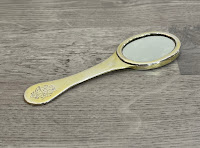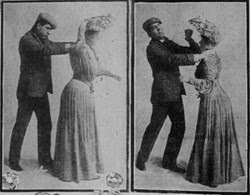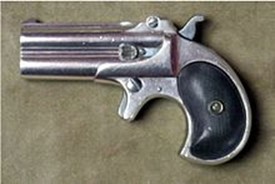Travel Essentials
- Mr. Houghton recommended carrying a sponge, tooth and nail brushes, soap in an oilskin bag.
The Modern Toothbrush
The first commercially produced, nice-smelling toothpaste was launched by Colgate and sold in a jar in 1873.
- Mr. Houghton also recommended a hairbrush, comb, hairpins, a small mirror, and towels should be carried in your traveling satchel.
 |
| Miniature travel mirror from 1872. |
The First Modern Mirrors
European glassmakers learned how to coat glass with a tin-mercury amalgam during the Renaissance, creating a perfectly reflective surface. Venice, known for its skilled glass artisans, became a center of high-quality mirror production in the 1500s, creating coveted ornate hand-made matching vanity sets, which usually included a hairbrush, a comb, and a handheld mirror. The first modern mirrors appeared in 1835 when Justus von Liebig developed a technique for coating glass with silver.
 |
| 1800’s Sevres or Sevres style vanity set, with a bristle brush and hand mirror, porcelain cherubs, mythical griffin art nouveau ormolu handle. |
Safety
- Another recommendation from the American Etiquette Rules of Politeness was to have a strong pocket made in your upper petticoat, and in that carry your money, only reserving in your dress pocket a small sum for incidental expenses.
 |
| A pair of pockets from the early 19th century. |
Safety First- looking beyond Mr. Houghton's recommendations-Pocket Pistols
The pocket pistol, also known as the Queen Anne pistol, originated in the mid-17th century as a small, concealable coat pistol or pocket pistol. This style was used during the 18th century, evolving from a weapon reserved for the wealthy to a common sidearm in broader use as more and more manufacturers made them by the start of the 19th century.
The boot pistol was another version of the muff pistol produced from 1800 until the 1850s, became popular with the Union army officers during the Civil War. These types of weapons were also frequently used by women because they were concealable in a purse.
When tucked into a vest or coat pocket, a derringer would not produce any more of a bulge in one’s clothing than would a pocket watch. Some manufacturers marketed their small firearms directly to the ladies. In 1866, Charles Converse and Samuel Hopkins manufactured approximately 800 pistols and sold under the trade name of “Ladies Companion.”
The 19th-century vest-sized pocket pistol was the double barrel, Philadelphia Deringer. The Rimfire Remington Model 95 was widely popular and overshadowed all other designs and became synonymous with the word, "Derringer." It is estimated that 150,000 were produced between 1866 and 1935. The Remington double-barrel derringer design is still being manufactured today.

The boot pistol was another version of the muff pistol produced from 1800 until the 1850s, became popular with the Union army officers during the Civil War. These types of weapons were also frequently used by women because they were concealable in a purse.
During the 18th century, wealthy travelers concealed small single-shot pistols in the pocket of a coat as protection from highwaymen. Overcoat pistols with a turn-off barrel were designed for women to carry in their muffs.
Boot pistol of the mid-Victorian era.
Original Remington Model 95 derringer
The 19th-century vest-sized pocket pistol was the double barrel, Philadelphia Deringer. The Rimfire Remington Model 95 was widely popular and overshadowed all other designs and became synonymous with the word, "Derringer." It is estimated that 150,000 were produced between 1866 and 1935. The Remington double-barrel derringer design is still being manufactured today.
Multi-purpose Hatpins
Not every Victorian woman possessed a firearm. But most well-dressed women possessed a hat and hatpin. Laws were passed in America in 1908 that limited the length. By 1910 ordinances were passed requiring hatpins to be covered with tips. |
| Hatpins and umbrellas were also used in self-defense and as Weapons |
| A Bride for David - Special Price for a Limited Time- Free on Kindle Unlimited |
Mathematics teacher Daisy Murphy agrees to participate in a new matchmaking service organized by her pastor and the matron of the orphanage where she has spent the last fifteen years. Romantic, yet practical, she's systematically eliminated all candidates but one and anticipates getting to know him better through months of correspondence.
Time is not on the side of David Taylor. He has a nephew and niece to think about, and his attorney has warned him he will lose custody of both to their rich grandfather if he doesn't have a wife.
A teacher longing for security, a businessman about to lose the only family he has; and a proxy marriage that can give them both exactly what they need.
Connect with Kimberly:

Kim has enjoyed writing since she was a young girl. However, she began writing her first novel in 2017, "I wear so many hats working inside and outside the home. I work hard, try harder, and then begin again the next day. Despite my best efforts, sometimes life just stinks. Bad things happen. I need and want an outlet, an opportunity to relax and escape to a place where obstacles are met and overcome."
Fans of historical romance set in the late 19th -century will enjoy stories combining, History, Humor, and Romance, emphasizing Faith, Friends, and Good Clean Fun.
Connect with Kimberly:
Bookbub: https://www.bookbub.com/profile/kimberly-grist
Facebook: https://www.facebook.com/FaithFunandFriends/
Twitter: https://twitter.com/GristKimberly
Amazon Author Page: https://www.amazon.com/Kimberly-Grist/e/B07H2NTJ71













No comments:
Post a Comment